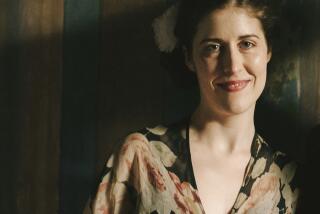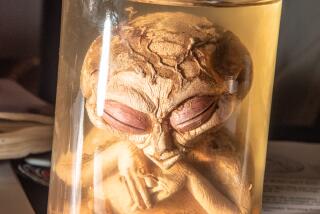Marriage Was in the Stars
- Share via
In the lush orange groves of Fillmore, flu-stricken Charles Morris viewed each frame of his space shuttle videotape through bleary eyes, wondering what had gone so tragically wrong.
Morris is one of those astronomy buffs who trudge up mountains and freeze for hours while the rest of the world sleeps, all for a fleeting vision that might strike less knowledgeable viewers as no more impressive than a smudge on their glasses.
One of the world’s authorities on the brightness of comets, Morris has “COMET GUY” on his license plate.
A few years ago he and his wife, Carmelita Miranda, took a stick and drew crude comets in the newly poured concrete walk beside their rural home. They were wed beside the most powerful telescope in Kauai. In their spare time they invite small groups into their backyard observatory for stargazing. On vacation last year, they rumbled over dirt tracks in the Australian outback to watch a solar eclipse.
So it wasn’t surprising they would grab their cameras and drive to a mountain north of Valencia for the return of the space shuttle Columbia.
Nor was it surprising that what they saw seemed at first to be only the predictable streak across the sky -- eight degrees above the horizon, as Morris points out.
“We didn’t know anything was wrong,” he said. “I never would have looked at the tape. I would have taken it home, labeled it, and put it into storage.”
The couple assumed the shuttle had landed at Cape Canaveral as planned, at 6:16 a.m. PST. But after the TV news shocked Morris with word of the accident, he pored over the one-minute videotape he had made at 5:54 a.m. On it, he discovered three odd blips of light bursting from the shuttle, one after the other.
He knows that the same phenomenon was noted by a Caltech astronomer looking skyward from his driveway in Bishop -- an observation that caused NASA to rethink its initial impression that whatever went wrong started over Texas.
So far, NASA has received more than 5,000 photos and videotapes related to the accident, said spokeswoman Kylie Moritz at the Johnson Space Center in Houston.
While many are views of debris on the ground, the images of the Columbia aloft are being strung together by analysts to create a visual timeline of the catastrophe.
“We’re lucky that a lot of people looked to the sky in the early morning to watch the re-entry,” Moritz said. “We’re trying to correlate the videos to the events that Mission Control has in its databank.”
Whatever NASA eventually concludes, the disturbing bit of history captured by the couple is another astronomic landmark in two lives marked with plenty of them.
JPL Engineer
Morris is an engineer at the Jet Propulsion Laboratory in Pasadena.
While his jaunt to Whitaker Peak to see the shuttle had nothing to do with his job, he has worked on high-tech systems that peer down on Earth from shuttles and satellites. In 2000, one of them yielded the most exhaustive map of the globe ever made.
It is in his off hours, though, that Morris has made his name among comet cognoscenti.
David Levy (of the comet Shoemaker-Levy)was the best man at his first wedding. Alan Hale (of the comet Hale-Bopp) was a sky-scanning buddy.
Morris runs a Web page that collects day-to-day comet sightings from observers around the world. Honoring his comet work, an astronomers’ group had the asteroid formerly known as 3783 named Morris.
“I got hooked on comets as a teenager,” he said. “What fascinates me is that they’re changing all the time. They can double in brightness overnight.”
The most brilliant comet in two decades brought Morris and Miranda together.
An avid sailor, Miranda had learned to navigate by the stars before piloting a 30-foot boat from her native San Francisco to Hawaii. Her interest in the heavens grew when, as an account executive for a radio station on Kauai, she got 2,000 listeners to come out to the beach and view a solar eclipse.
By the time the comet Hyakutake flashed across the skies in 1996, she was putting together an astronomy group’s newsletter and needed Morris’s permission to lift a star chart from his Web site.
One e-mail led to another, and ultimately the stars lined up.
“If it wasn’t for that comet, I wouldn’t have met him,” Miranda said.
“And it was one of the most beautiful things I’ve ever seen. When I looked up, it was as if I could reach out and catch it in my arms. It was coming at me in all its glory.”
Astro-Photographer
Miranda now makes her living amid the stars. She is an accomplished astro-photographer. And she runs an outreach program for the fledgling Discovery Center in Thousand Oaks, hauling an inflatable planetarium to schools and giving talks to wide-eyed students all over Ventura County.
Together, the couple run a part-time business called Kool Space Science, charging visitors $7 for an evening of stargazing from the observatory in their yard. Open for business one night a month spring through fall, they’re not hoping to get rich.
Shed With Roll-Off Roof
“This is just kind of a neat thing to share,” Miranda said.
“Sometimes older folks in RV groups walk up here from Kenney Grove Park just down the street. It’s nice and convenient.”
A 10-by-12-foot shed with a roll-off roof, the observatory gives viewers the sun in the morning -- there’s a telescope especially equipped for solar viewing -- and the galactic panorama at night.
“They see whatever is current in the sky,” Miranda said.
“They can see Saturn or Jupiter, or Orion’s nebula, where baby stars are born.
“And if they see a globular cluster -- well, it’s fantastic. People are just wowed. It’s like burst of fireworks! It’s definitely an ooh-and-aah kind of thing,” she said.
More to Read
Sign up for Essential California
The most important California stories and recommendations in your inbox every morning.
You may occasionally receive promotional content from the Los Angeles Times.











